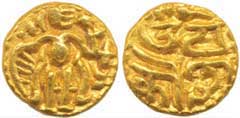Socio-economic Life
Caste system was widely prevalent during the Chola period. Brahmins and Kshatriyas enjoyed special privileges. The inscriptions of the later period of the Chola rule mention about two major divisions among the castes – Valangai and Idangai castes. However, there was cooperation among various castes and sub-castes in social and religious life. The position of women did not improve. The practice of ‘sati’ was prevalent among the royal families. The devadasi system or dancing girls attached to temples emerged during this period.
 |
| GOLD COIN OF CHOLA |
and maintenance of irrigation tanks led to agricultural prosperity. The weaving industry, particularly the silk-weaving at Kanchi flourished. The metal works developed owing to great demand of images for temples and utensils. Commerce and trade were brisk with
trunk roads or peruvazhis and merchant guilds. Gold, silver and copper coins were issued in plenty at various denominations. Commercial contacts between the Chola Empire and China, Sumatra, Java and Arabia were extensively prevalent. Arabian horses were imported in large numbers to strengthen the cavalry.
Education and Literature
Education was also given importance. Besides the temples and mathas as educational centres, several educational institutions also flourished. The inscription at Ennayiram, Thirumukkudal and Thirubhuvanai provide details of the colleges existed in these places.
Apart from the Vedas and Epics, subjects like mathematics and medicine were taught in these institutions. Endowment of lands was made to run these institutions.
